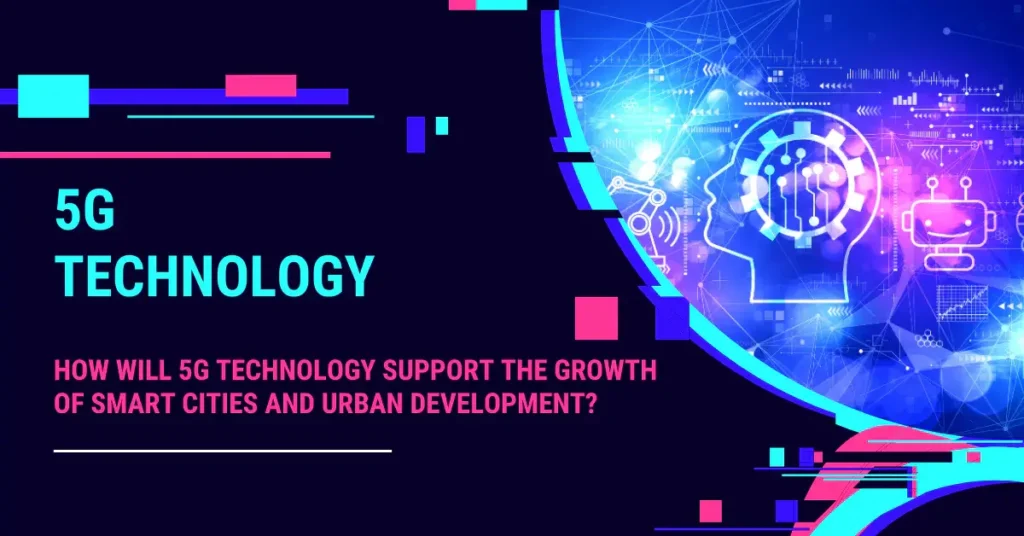The world is changing quickly, and our cities are evolving right along with it. One of the biggest drivers of this change is 5G technology and better networking due to the reach of the internet to villages and undeveloped areas. But what is 5g technology, and how will it help our cities grow smarter and more advanced? In simple terms, 5G is the fifth generation of wireless technology. It’s much faster and more reliable than the 4G we use today. This means that everything from your smartphone to huge city infrastructure will be able to communicate more quickly and efficiently.
Imagine living in a city where traffic lights instantly adjust to the flow of cars, reducing traffic jams. Or think about smart buildings that can save energy by automatically adjusting lighting and temperature based on the number of people inside. With 5G, these innovations are not just dreams—they are becoming a reality as the Technology is more connected with artificial intelligence.
5G will support the growth of smart cities by making it easier to collect and analyze data, connect more devices, and improve services. From better public safety systems to cleaner environments, 5G is set to revolutionise urban life. In this blog, we’ll explore how 5G technology will support the development of smarter, more efficient cities and enhance the way we live and work.
Exploring the Role of 5G in Shaping Future Cities
As we look to the future, one technology stands out as a game-changer for urban development: 5G. This fifth-generation 5g wireless technology promises to revolutionise how cities function, making them smarter and more efficient. With its high-speed connectivity and low latency, 5G enables real-time data sharing and seamless communication between countless devices.
Imagine a city where traffic lights adapt instantly to traffic flow, reducing congestion and emissions. Smart grids can balance energy use, leading to more sustainable living. Public services, from healthcare to security, can respond faster and more effectively. Moreover, 5G will enhance the Internet of Things (IoT), connecting everything from streetlights to garbage bins, creating a network of smart, interconnected systems.
In essence, 5G is the backbone of future cities, providing the necessary infrastructure for advanced technologies to thrive. By supporting innovations in transportation, energy, and public services, 5G is set to transform urban life, making cities safer, greener, and more livable.
The Impact of 5G on Urban Innovation and Growth
The introduction of 5G technology is revolutionising urban areas by driving innovation and growth. With its lightning-fast speed and low latency, 5G enables smarter cities where everything is interconnected. It supports advancements in traffic management, reducing congestion and emissions through real-time data on live map applications like google maps.
In healthcare, 5G facilitates remote surgeries and telemedicine, making healthcare more accessible. It also enhances public safety with improved surveillance and quicker emergency response. Businesses benefit from 5G through enhanced productivity, faster data transfer, and the potential for new services and products.
5G supports the development of autonomous vehicles, which promise safer and more efficient transportation. It also plays a crucial role in the expansion of the Internet of Things (IoT), connecting devices and systems for better urban management.
Role of 5G in Enhancing IoT Connectivity
5G technology plays a crucial role in enhancing IoT (Internet of Things) connectivity by offering faster speeds, lower latency, and the ability to connect more devices simultaneously. Unlike previous networks, 5G can support billions of devices efficiently, making it ideal for the growing number of IoT applications.
With 5G, smart homes can become more responsive, with appliances communicating seamlessly. In healthcare, it enables remote monitoring of patients with real-time data. Industrial IoT benefits from 5G through improved automation and control of machinery, leading to increased productivity and safety.
Impact of 5G on Transportation Systems
With its ultra-fast speeds and low latency, 5G allows vehicles to communicate seamlessly with each other and with traffic management systems in real-time. This capability is crucial for the development of autonomous vehicles, which rely on instant data exchange to navigate safely and efficiently.
5G supports advanced features like vehicle-to-everything (V2X) communication, which includes vehicle-to-vehicle (V2V), vehicle-to-infrastructure (V2I), and vehicle-to-pedestrian (V2P) interactions. These capabilities improve road safety, reduce traffic congestion, and enhance overall transportation efficiency.
In urban areas, 5G enables smart traffic management systems that can dynamically adjust traffic signals based on real-time data, optimising traffic flow and reducing emissions. Additionally, passengers benefit from enhanced connectivity inside vehicles, allowing for seamless multimedia streaming and real-time navigation updates.
5G-powered Infrastructure and Utility Management
In cities, 5G helps utilities optimise energy usage by collecting data instantly from smart metres and sensors. This capability leads to more efficient resource allocation and reduced costs. For example, maintenance crews can respond faster to issues detected by sensors, preventing potential disruptions.
Industries benefit as well, with 5G supporting remote monitoring and predictive maintenance of machinery. This proactive approach minimises downtime and improves overall operational efficiency. Moreover, autonomous vehicles and smart traffic systems rely on 5G’s reliability to enhance transportation management and safety.
5G-powered infrastructure management transforms how we manage utilities and infrastructure, making cities smarter and industries more resilient. As this technology evolves, its impact on efficiency and sustainability will continue to grow, shaping a more connected and efficient future.
5G Applications in Public Safety and Security
Emergency responders can now benefit from faster and more reliable communication networks, enabling quicker response times during crises. Real-time video streaming and high-definition imaging allow for better situational awareness, aiding in effective decision-making on the ground.
In urban areas, 5G supports smart surveillance systems that can analyze large volumes of data quickly, enhancing monitoring capabilities and improving overall safety. Moreover, wearable devices equipped with 5G connectivity enable continuous health monitoring of firefighters and police officers in hazardous situations, ensuring their well-being.
5G-powered drones and robots can be deployed for remote monitoring and reconnaissance, providing valuable insights in emergencies or natural disasters. This technology also facilitates seamless coordination among different agencies through secure and high-speed networks, enhancing overall response efficiency.
Challenges and Solutions in Deploying 5G for Urban Development
Deploying 5G in urban areas presents challenges but also solutions to improve development:
Infrastructure: Existing infrastructure needs upgrades to support 5G’s high-speed and low-latency requirements.
Cost: Deployment costs are high due to the need for new equipment and extensive network densification.
Regulations: Regulations must adapt to accommodate new 5G technologies and antenna placements.
Community Concerns: Addressing public concerns about health, privacy, and aesthetics of new infrastructure.
Solution – Collaboration: Governments, telecom companies, and urban planners collaborate to streamline deployment processes.
Solution – Small Cells: Implementing small cells and micro-towers to enhance coverage and reduce congestion.
Solution – Public-Private Partnerships: Encouraging partnerships to share costs and resources for faster deployment.
Solution – Education: Educating the public about the benefits and safety of 5G to gain community support.
Solution – Future-Proofing: Designing networks that can evolve with technology advancements to sustain urban growth.
By addressing these challenges with strategic solutions, cities can harness 5G’s potential to foster smarter, more connected urban environments.
Benefits of 5G for Residents and Businesses in Smart Cities
For residents, it means faster internet speeds on their smartphones and other devices. This allows people to stream videos, make video calls, and download large files quickly and smoothly. Smart city services like traffic management and public safety can also improve with 5G, as data transmission becomes almost instantaneous.
Businesses in smart cities benefit from 5G by enhancing productivity and efficiency. They can use advanced technologies like augmented reality (AR) and virtual reality (VR) more effectively for training and customer engagement. Moreover, 5G enables faster data transfer and more reliable connections, supporting innovations in sectors such as healthcare, logistics, and manufacturing.
Collaborations between Technology Providers and Urban Planners
Collaborations between technology providers and urban planners are essential for creating smarter cities. Technology firms bring innovations like data analytics, AI, and IoT solutions that can improve urban infrastructure and services. They help planners gather and analyze data on traffic patterns, energy usage, and public health to make informed decisions.
Urban planners, on the other hand, provide valuable insights into local needs and regulations. They ensure that technology solutions align with community goals and benefit all residents equitably. Together, they can design sustainable transportation systems, enhance public safety through smart city initiatives, and optimise resource management.
These collaborations foster efficient city management, making cities more livable and resilient. By combining expertise, technology providers and urban planners can tackle complex challenges and create inclusive environments where technology enhances the quality of life for everyone.
Public-Private Partnerships in Building Smart Cities with 5G
Public-private partnerships (PPPs) are crucial in developing smart cities with 5G technology. Governments and private companies work together to improve urban infrastructure and services using advanced connectivity.
5G enables faster internet speeds and connects more devices, making cities smarter. With PPPs, governments provide regulations and infrastructure support, while private companies invest in technology and innovation. Together, they build smart transportation systems, efficient energy management, and enhanced public safety.
Innovations in Healthcare and Education with 5G in Smart Cities
In smart cities, 5G technology is revolutionizing healthcare and education. With its fast speeds and low delays, 5G allows doctors to monitor patients remotely in real-time, improving healthcare access and efficiency. It enables the use of advanced medical devices and telemedicine services, making healthcare more accessible to people in remote areas.
In education, 5G enhances learning through immersive experiences like virtual classrooms and augmented reality. Students can access high-quality educational resources anywhere, facilitating personalised learning. Teachers can also collaborate more effectively across distances, enriching the educational experience.
In smart cities, these innovations transform how healthcare and education are delivered, ensuring better outcomes and opportunities for everyone. As 5G continues to evolve, its impact on these essential sectors promises to create smarter, more connected communities where access to quality healthcare and education is more equitable and efficient.
Will 5G have any negative impact on smart cities and urban areas?
While 5G brings many benefits to smart cities and urban areas, there are also potential drawbacks to consider. One concern is the increased electromagnetic radiation exposure due to the higher frequency waves used in 5G networks. Some studies suggest possible health risks, although scientific consensus is still evolving.
Another issue is the cost and infrastructure needed to deploy 5G. Building new towers and upgrading existing ones can be expensive and time-consuming. This could lead to disparities in access between different neighbourhoods or regions.
Moreover, 5G’s reliance on high-frequency waves means it has a shorter range compared to previous networks. This could result in more cell towers needing to be installed, potentially impacting the aesthetics and environment of urban areas.
Click to read more blog related to technology.



